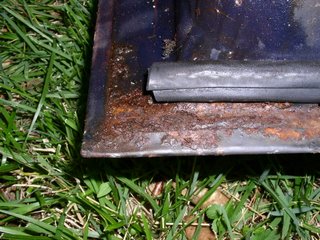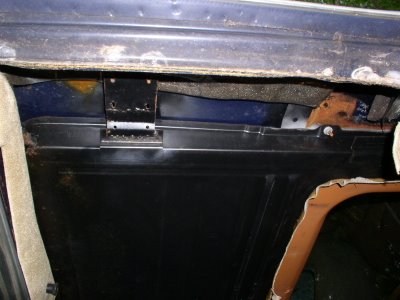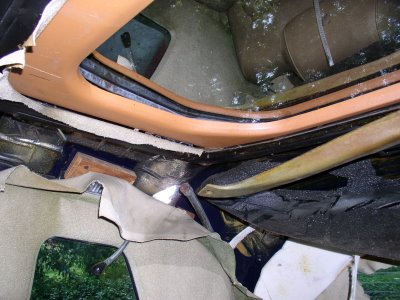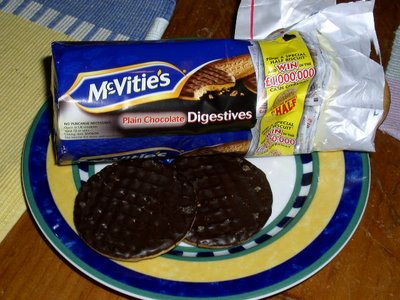Bomb has a new home.
I've been looking at Taxis for sale here. It may be awhile before bomb mark II arrives. I just failed my driving test. By one point.

 Today, I discovered bonus rust. I took off the driver's door and the trim covering the inner sills. As I suspected, the left side 'b' pillar is rotted through. There isn't much holding it in at the bottom. I'm not sure how to repair that yet. The sills (rocker panels in American) don't look good either. The sills are made up of several bolt on parts as well as some welded panels. I'm not sure what is going to happen when I undo the bolts. The frame should keep the body together but a lot of the body is missing.
Today, I discovered bonus rust. I took off the driver's door and the trim covering the inner sills. As I suspected, the left side 'b' pillar is rotted through. There isn't much holding it in at the bottom. I'm not sure how to repair that yet. The sills (rocker panels in American) don't look good either. The sills are made up of several bolt on parts as well as some welded panels. I'm not sure what is going to happen when I undo the bolts. The frame should keep the body together but a lot of the body is missing.
 I've started looking for body sheet metal. I need an entire body shell, but that isn't possible. Taxis still are assembled by hand. The individual parts are put in a jig and a few workers weld the panels together. If I can get the parts, I should be able to recreate the process. Cut out the rusted part. Clamp a new part in a jig. Weld it in. Easy. All I need are the parts, a factory, the custom made jigs and someone that knows how to weld.
I've started looking for body sheet metal. I need an entire body shell, but that isn't possible. Taxis still are assembled by hand. The individual parts are put in a jig and a few workers weld the panels together. If I can get the parts, I should be able to recreate the process. Cut out the rusted part. Clamp a new part in a jig. Weld it in. Easy. All I need are the parts, a factory, the custom made jigs and someone that knows how to weld.
 After removing the rear doors, I decided to pull off the rear wings. The wings are fastened to the body shell with bolts along the top and sheet metal screws along the bottom. There are a couple of machine screws at the door frame. I soon realized there were two or three screws I wasn't able to reach from the boot. I puzzled over this for a few minutes and then started taking the interior apart. There had to be an access panel or door. Well I was half wrong. I pulled out the rear seat and the quarter trim panels and there was the wing. There isn't any other metal. The right wing was badly corroded. I had to use my cut off tool in several places. The left wing came off quickly, mostly because I knew what to do this time. I pulled up the carpet from the rear to help cut down on the smell, then stepped back for a minute to take a look at the car.
After removing the rear doors, I decided to pull off the rear wings. The wings are fastened to the body shell with bolts along the top and sheet metal screws along the bottom. There are a couple of machine screws at the door frame. I soon realized there were two or three screws I wasn't able to reach from the boot. I puzzled over this for a few minutes and then started taking the interior apart. There had to be an access panel or door. Well I was half wrong. I pulled out the rear seat and the quarter trim panels and there was the wing. There isn't any other metal. The right wing was badly corroded. I had to use my cut off tool in several places. The left wing came off quickly, mostly because I knew what to do this time. I pulled up the carpet from the rear to help cut down on the smell, then stepped back for a minute to take a look at the car. This is the left rear quarter where the wing attaches. Rust is from bad body work.
This is the left rear quarter where the wing attaches. Rust is from bad body work. This is the right rear below the tail light. The view is from inside the boot looking out.
This is the right rear below the tail light. The view is from inside the boot looking out. The rust is worse than my latest pessimistic prediction. This last picture is the left b-pillar viewed from the back of the car. It is rusted through at the back. So is the bottom of the partition. What? The right side of the car is usually worse. There was no collision damage here. So what caused this rust? My first thought was condensate water from the nearby AC unit. Along with broken glass there were some rags stuffed under the thing. It must have dripped all the time. But this was a lot of rust and the car only ran for 2 or 3 years. Water must have... No it didn't. I was looking at the broken glass and had completely forgotten that glass belonged to the driver's door window. Water came in through the window, pooled on the floor and caused serious damage. Now I was really worried. I decided to pull up the floor boards. If the frame was rusted through, the bomb might be a lost cause.
The rust is worse than my latest pessimistic prediction. This last picture is the left b-pillar viewed from the back of the car. It is rusted through at the back. So is the bottom of the partition. What? The right side of the car is usually worse. There was no collision damage here. So what caused this rust? My first thought was condensate water from the nearby AC unit. Along with broken glass there were some rags stuffed under the thing. It must have dripped all the time. But this was a lot of rust and the car only ran for 2 or 3 years. Water must have... No it didn't. I was looking at the broken glass and had completely forgotten that glass belonged to the driver's door window. Water came in through the window, pooled on the floor and caused serious damage. Now I was really worried. I decided to pull up the floor boards. If the frame was rusted through, the bomb might be a lost cause. Taxis have wooden floors. They are designed to be removed during a PCO inspection. The frame is still in good condition. So are the areas where the body mounts onto the frame.
Taxis have wooden floors. They are designed to be removed during a PCO inspection. The frame is still in good condition. So are the areas where the body mounts onto the frame. Taxi enthusiast and journalist Murray Jackson sent me scans of his London Coach information packet. Included was a list of optional and standard equipment. The original owner ticked very few of the option boxes. Surprisingly he picked the most expensive and least common ones.
Taxi enthusiast and journalist Murray Jackson sent me scans of his London Coach information packet. Included was a list of optional and standard equipment. The original owner ticked very few of the option boxes. Surprisingly he picked the most expensive and least common ones.Total price in 1986 with options was $31,505. I bought a brand new car that year for $7,000.
 Even without the spare and the jack, a London Taxi's boot won't hold much more than a pair of golf shoes, 3 golf balls, a pair a socks and a tooth pick.
Even without the spare and the jack, a London Taxi's boot won't hold much more than a pair of golf shoes, 3 golf balls, a pair a socks and a tooth pick.
London Coach offered this luggage cover as a solution. The cover snaps onto the back side of the body. A simple aluminum frame supports the cover. The inside of the boot lid has some rubber runners to support luggage. A pair of straps hold bags down.


 The bomb has a factory installed electric moon roof in the passenger compartment. I've never seen another taxi with this very rare option. Some London Taxis have a sunroof for the driver but never for the passengers.
The bomb has a factory installed electric moon roof in the passenger compartment. I've never seen another taxi with this very rare option. Some London Taxis have a sunroof for the driver but never for the passengers. There are brackets welded in over the rear door openings. They appear to take most of the weight of the sunroof and the compartment the glass goes into when the roof is open. This first photo is from the left side looking up.
There are brackets welded in over the rear door openings. They appear to take most of the weight of the sunroof and the compartment the glass goes into when the roof is open. This first photo is from the left side looking up. This view is looking across to the right side. There are two brackets on each side. The first one is the black thing with 3 slots. The other bracket is just to the right. It is still covered with insulation. The passenger compartment lamps are mounted to wood blocks!
This view is looking across to the right side. There are two brackets on each side. The first one is the black thing with 3 slots. The other bracket is just to the right. It is still covered with insulation. The passenger compartment lamps are mounted to wood blocks! There are drain lines at all four corners of the moonroof. Both rear drain hoses are disconnected. Water from the sunroof drains is what ruined the old headliner. The disconnected hoses may also be the cause of the some of the body rust. The sunroof motor is at the back. There may be another bracket there. The batteries died on my camera before I could take a look.
There are drain lines at all four corners of the moonroof. Both rear drain hoses are disconnected. Water from the sunroof drains is what ruined the old headliner. The disconnected hoses may also be the cause of the some of the body rust. The sunroof motor is at the back. There may be another bracket there. The batteries died on my camera before I could take a look.
 In the early 1960's there were several incidents where passengers trying to roll down the windows unintentionally opened the rear doors. A child was killed in 1961 while trying to roll down the windows with door handle. When another child fell from a cab and was killed in 1982, the PCO mandated window stickers showing that the windows are opened by pulling them down. The PCO also required that the door handles be covered with a plastic shield.
In the early 1960's there were several incidents where passengers trying to roll down the windows unintentionally opened the rear doors. A child was killed in 1961 while trying to roll down the windows with door handle. When another child fell from a cab and was killed in 1982, the PCO mandated window stickers showing that the windows are opened by pulling them down. The PCO also required that the door handles be covered with a plastic shield.
My tyres arrived at 2PM Friday. The rain started at 5:30PM. Severe thunderstorms were enough to keep me and the bomb inside. By mid-morning Saturday the storms had settled down to a steady rain. I was not about to be put off by a little water. I put the right side of the bomb on one of HF dollies and dragged the bomb out. The left wheel lug nuts were close to seized. A lot of WD-40 and jumping on the end of my flex handle got them free. I was of course thoroughly soaked by the time I got both wheels into the trunk of my BMW.
I didn't want to risk damaging my hard won Michelin taxi tyres on the HF manual tire changer. I drove to a nearby tire Kaufman Tire store. That's where I found out that Kaufman Tire will not mount tires purchased elsewhere. A trunk full of impossible to obtain taxi tyres didn't change matters. Slipping one of the mechanics $30 to do the job on the side did.

 The tyres have TAXI molded into the side wall. I believe that is a PCO requirement. Leave a comment if I'm wrong.
The tyres have TAXI molded into the side wall. I believe that is a PCO requirement. Leave a comment if I'm wrong.

Sunday I pushed the bomb out to work on it. Not even pushed really. The garage floor has a slight slope and the car rolled most of the way out.
I started taking the doors apart. The right passenger door is rusted at the bottom. I had hoped that I could save the inner part of the door and just replace the skin. Power windows were a rare factory option. I'll figure out what I'm going to do with them when the replacement doors arrive.
A recent post in the London Taxi Cabs group listed the number of FX4R vehicles still registered for on-road in the UK. The numbers shocked me. 1982 - 8, 1983 - 5, 1984 - 11, 1985 - 17. Another 60 are listed as SORN. Most or all of those 60 will never drive on the road again. Only 19 of the 2151 FX4S taxis from 1986 are still licensed for use on the road.
Although my Sterling is 1986 MY, the chassis number (616xx) puts it near the end of 1985 FX4R production. I know of 3 London Coach cars. I've seen 2 on eBay. Both ran. Then there is mine. A Sterling is in the LVTA roster but I think it is one of the two cars I saw on eBay. And there are the 17 cabs in the UK that run. Of the all the units Carbodies made in the last year of FX4R production only 19 are currently road worthy. I will make it 20. The rest of you: Keep after the rust!
EDIT: 2 London Coach owners have posted comments. There are at least 5 or 6 London Coach cabs still around, including mine.

After waiting a few weeks, I emailed Longstone Tyres to find out why they hadn't charged me yet. I waited a day and had no response. Then I checked the spam folder. Emails from Nigerian bankers wanting to give me a million dollars make it to my inbox. But Longstone Tyres asking if I really want to put taxi tyres on my vintage car. Well that must be spam. Thanks yahoo.
Most of Longstone's customers have true vintage cars. They used to sell taxi tyres as a stop gap until suitable tyres became available. Turns out I'm their first customer with an actual taxi. Longstone has been great. Simon just sent me the photo of my new tyre. We have a few more hurdles to clear but I'll get them eventually.
I decided to stop waiting for the new tyres and figure out what is wrong with the space saver on the right rear. A soapy water test showed the tire was leaking along the bead. Made me wonder if the problem was the rim, not the tire. I needed to pop the tire off and have a look. Harbor Freight had a manual tire changer on sale for about what it would cost me to have a shop mount and unmount the tire.

The tire changer has to be bolted to a solid surface. Whoever owns our house next will be wondering why there are so many anchors in the garage floor. I'm up to 11 now.


The Manual Tire changer works like any other Harbor Freight tool. They are cheap. You have to shove on them so hard you wonder what is going to break first. In my case it was the tire bead. That's a good thing. It was supposed to break. Once the tire was off, the problem was obvious. The wheel was full of crud. The sort of stuff you'd expect on a wheel that had been in a barn for 15 years. The guy at the used tire store hadn't cleaned it off. The tire bead wasn't making a good seal.
 After cleaning, I discovered the rim is bent. It is ok for now. I will have to replace it before I can drive the bomb. Three taxi rims just sold for 99p on eBay. Pick up only. Somewhere in North London. I was not able to remount the tire. It was the end of the day and I was already worn out from getting the tire off. I'll try again soon. Beats lifting weights.
After cleaning, I discovered the rim is bent. It is ok for now. I will have to replace it before I can drive the bomb. Three taxi rims just sold for 99p on eBay. Pick up only. Somewhere in North London. I was not able to remount the tire. It was the end of the day and I was already worn out from getting the tire off. I'll try again soon. Beats lifting weights.
2 x 175SR16 Dunlop Trident Taxi Tyre (ZZ1193) @ US Dollars 99.18
Goods Total: US Dollars 198.36
Delivery: US Dollars 34.80
Tax: US Dollars 0.00
Estimated Grand Total in Your Currency: US Dollars 233.16
Actual Grand Total in Transactional Currency: GB Pounds 134.00
Seed the dried chilies (or not if you like the seeds) Boil some water. Take it off the heat and soak the chills in the water. While the chilies are soaking peel and quarter the onion. Crush and peel the garlic. Place the onion and garlic in a food processor. Drain the chilies and place in food processor. Put on the lid and puree. Heat oil or butter in a large pot. Clarify butter. Crank the heat all the way up. Fry the chili puree for a few minutes then add the meat. Brown the meat. Add the tomatoes and the paste. Add about a cup of water. Heat to boil and then reduce heat to low. Cook a few hours. Add water as needed. Serve with plain rice, corn tortillas and a salad. Sour cream if you want it.
Chipolte is a smoked dried jalapeno. No substitute for this ingredient. I've use several varieties of chilies for the others. Each brings a unique flavor. Some are hotter than others. If you have a choice, start with Ancho chilies.

Whole Foods has chocolate biscuits. Chocolate Biscuits are the single best thing English culture has produced. You can't eat the Magna Carta. And you can't get Chocolate Biscuits here. Not at the grocery store anyway. July 3rd I bought 20 packs at the Sainsbury's across from the Russel Square tube station. We've been out since October.
So what are they? As an American, I would say they are kinda like chocolate covered Gram Crackers. That is the same as saying tea is kinda like coffee. They are chocolate biscuits and there is no substitute.
Biscuits come in a variety of flavors. Rich Tea, Digestive, wholemeal. They can be covered with plain chocolate or milk chocolate. Our favorite is the Plain Chocolate Digestive. Sainsbury's store brand are the best. McVities are a close second. If only the bomb was as well executed as those biscuits.
The FX4 taxi design was a great idea. The overall layout of the car, use of space, visibility are all fantastic. Certainly groundbreaking in 1959. But there are many flaws. A few were fixed over the 30 years the taxi was in production. Many never were.

These Lucas 7FJ fuse boxes are in just about every taxi ever built. By 1986 this sort of fuse box was entirely obsolete. The boxes are mounted to the driver side of the engine compartment, near the front. In this area they are exposed to road spray. The boxes are not sealed. The spade connectors aren't either. Corroded fuse box connections are a constant problem. I managed to find two NOS (new old stock) fuse boxes. I'm not sure if I am going to use them. A fuse box from a BMW would work much better.
(For anyone wondering: Yes, I missed the Bombings by a few days. Debbie was still in London and about a block away from the Tavistock Square bomb when it went off.)

Sunday I pulled all the parts off the two wings. The wings on an FX4 are in two halves. I've never seen another car built like this. Splitting the wings was supposed to reduce the cost of collision repairs. I doubt it was anything but a source of rattles. A few hours work produced a box full of rusty bits along with the 4 wing panels. The right wing went directly to the trash. I don't have much hope for the box of rust. The headlight buckets are both bent. So are the metal gaskets that goes behind them. The rest of the right head light assembly was missing. The left might as well have been. New headlamp parts are available, just expensive.
The front side marker lamps are a different story. They are in very bad condition. I may be able to save the lenses. The side markers on the Bomb are not the same as an ordinary FX4 taxi. To meet US DOT requirements, Carbodies used parts from other British cars. I recognized the rear markers from an MG Midget. I've looked and they are available at $57.00 each. I looked at lots of photos and the fronts appear to be from a Triumph. No longer available. I'll see what turns up. Norm may have a set. I can always use the side markers from an 1980's FX4. I may have to.